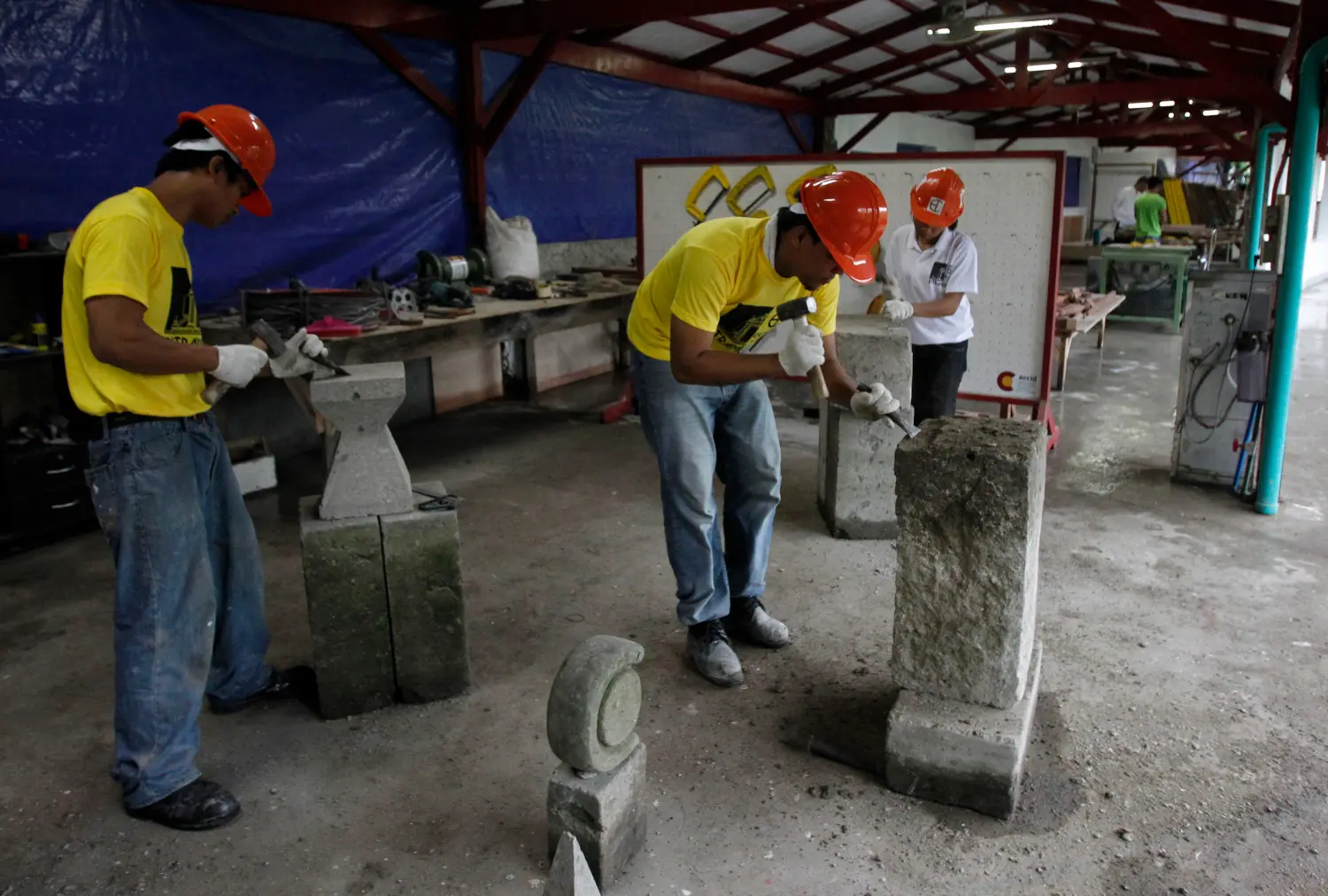Career and technical education (CTE) has traditionally played an important role in U.S. secondary schools. The first federal law providing funding for vocational education was passed in 1917, even before education was compulsory in every state.1
CTE encompasses a wide range of activities intended to simultaneously provide students with skills demanded in the labor market while preparing them for post-secondary degrees in technical fields. Activities include not only specific career-oriented classes, but also internships, apprenticeships and in-school programs designed to foster work readiness.
CTE advocates cite several goals of career-oriented learning experiences. For non-college-bound students, CTE can provide hands-on training that translates directly to attractive careers upon graduation. Work-related or internship-like experiences that are often a part of CTE can teach students the “soft skills” necessary in the labor market. Finally, by integrating academic skills into a “real world” context, advocates claim that CTE can motivate students to attend school more frequently and be more engaged, and therefore improve core academic skills.
However, CTE has been on the decline for several decades. Starting in the 1980s, states increased the number of courses required for high school graduation, and began mandating students take additional courses in core academic areas such as math, science, social studies and foreign language.2 These additional requirements, along with declining funding3 and a growing perception that all young people should be encouraged to obtain a four-year college degree, led to a sharp decline in CTE participation. Between 1990 and 2009, the number of CTE credits earned by U.S. high school students dropped by 14 percent.4
The past decade has seen a resurgence in interest in CTE. Scholarship in the area of education and the labor market has increased markedly.5 In the past four years alone, media mentions of “career and technical education” have quadrupled.6 In 2015 alone, 39 states instituted 125 new laws, policies or regulations relating to CTE, many of which increased state funding for such programs. Montana, for example, doubled the annual statewide appropriation for secondary CTE; Nevada tripled its funding.7
Unfortunately, research on CTE has not kept pace with policy interest.8
What does earlier non-experimental research tell us?
Prior non-experimental evidence suggests that students who participate in secondary CTE programs have higher employment and earnings than demographically-similar peers in the short run, but they do not necessarily have better academic outcomes. For example, many studies show little or no differences between CTE participants and comparison groups in terms of academic achievement, high school graduation or college enrollment.9
A good example of this type of research is a recent study by Daniel Kreisman and Kevin Stange, which relies on data from the NLSY97, a nationally representative sample of 12- to 17- year-old youth in 1997 that tracks individuals over time.
They find that CTE participation is not strongly associated with educational attainment – CTE students are marginally less likely to enroll in college but no less likely to earn a degree – but CTE coursework does predict employment outcomes. Importantly, they find that CTE participation is associated with higher wages, with the increase driven entirely by upper-level coursework, defined as courses within a sequence beyond the introductory class, in more technical fields. Each additional year of upper-level vocational coursework is associated with a nearly 2 percent wage increase.10 This suggests that the benefits of CTE education stem from in-depth study of a specific area consistent with the recent trend toward “pathways of study” within CTE.11
As the authors recognize, however, the biggest challenge in evaluating CTE is that students typically self-select into such programs, or student choices are circumscribed by the types of programs offered in nearby schools. In either case, it is likely that students participating in CTE are different in many ways than other youth who do not participate in CTE – in terms of their personal abilities and interests, family background, etc. On the one hand, many observers have described CTE as a “dumping ground” for lower-achieving or unmotivated students.12 On the other hand, because CTE is not the “default” pathway, the students who participate must be at least somewhat motivated and informed.13
CTE can motivate students to attend school more frequently and be more engaged, and therefore improve core academic skills.
Kreisman and Stange attempt to circumvent this selection problem using what researchers refer to as an instrumental variables strategy. Simply put, they compare students across schools with different high school graduation requirements because, as they show, the greater the number of required courses, the fewer CTE courses students take. Using this approach, they find that the wage benefits associated with CTE disappear.
However, a key assumption here is that, after controlling for observable student and school characteristics, the students attending high schools with fewer graduation requirements are identical to those attending high schools with more graduation requirements.14 As the authors recognize, this is a very strong assumption. If this assumption is true, it implies that students whose CTE course-taking is influenced by graduation requirements realize little benefit from it. Of course, it may still be the case that those who self-select into CTE benefit from it, and that prohibiting them from doing so would be detrimental.
A further complication is that virtually all of the existing research on CTE has focused on relatively short-run outcomes. This is a notable limitation because many believe that career-focused education involves a tradeoff – namely, learning a narrower set of technical skills that can provide short-run benefits at the expense of learning more fundamental skills that will better serve individuals in the long-run.15 Indeed, a recent study using European data finds some evidence of exactly this type of tradeoff.16 Given the changes we expect to take place in the labor market in coming years, and how often individuals might need to switch occupations, this is a potentially serious concern. Of course, advocates of CTE argue – with some justification – that career-oriented education today does aim to teach core academic skills essential to lifelong learning, and often does so better than traditional schooling, particularly for disadvantaged youth.17
the gold standard
The single best way to avoid such selection problems and determine the causal impact of a policy or program is through a randomized control trial. While such experiments can be expensive and are often logistically or politically difficult, they have a long history in education policy research. Other research designs, known as quasi-experimental research, attempt to approximate the same design with statistical techniques.
According to the What Works Clearinghouse, for example, there are 83 programs with experimental or quasi-experimental evidence in the area of early childhood education, 39 programs for dropout-prevention, and 32 programs for English language learners.
In the area of secondary CTE, there is only 1. Yes, one. This study examined Career Academies in the early 1990s, before many of the occupations common today even existed and prior to the introduction of policies with important implications for secondary schools (e.g., school accountability).18
Structured as distinct programs embedded within comprehensive high schools, the Career Academies provided students with career-oriented instruction in a particular field along with internships and other activities to prepare students for, and connect them with, the labor market. The schools in the study were located in or near large urban areas with predominantly low-income minority student populations. The Career Academy programs were oversubscribed, which permitted admissions to be determined by lottery.
Researchers found that Career Academies had no impact (positive or negative) on high school graduation, postsecondary enrollment or educational attainment. However, the study found that students who received the opportunity to attend a career academy earned 11 percent more than the control group. Interestingly, this positive wage effect was driven entirely by male students, who enjoyed a 17 percent earnings boost. Males defined as high-risk based on baseline characteristics (i.e. prior to high school) realized the largest benefits from the program. There was no significant difference between the earnings of females in the treatment and control group.
This single study has been cited hundreds of times, and is featured prominently in nearly every literature review and many policy proposals regarding CTE. While this was an extremely well-done evaluation of an important CTE model, it has important limitations. As noted elsewhere, Career Academies are a small component of CTE provision nationwide.19 The study itself focused on a small number of sites which, as evidenced by their oversubscription, were perceived as high quality.20
and then there were two
Compelling research on CTE recently doubled with the release of a new study of regional vocational and technical high schools (RVTS) in Massachusetts.21
Unlike the Career Academies described above, RVTS are entire schools devoted to career-oriented instruction. Students spend one week in the classroom followed by one week in a technical shop. While students in other schools have access to CTE courses, RVTS offer more variety in terms of the program of study, and the programs themselves are typically higher quality than those found in comprehensive high schools.
The author of the study, Shaun Dougherty, obtained detailed data on student applications to three RVTS. Because the schools are often oversubscribed, they admit students on the basis of their attendance, grades and discipline record in middle school. By comparing the educational outcomes of students who scored just above the admissions threshold (and thus were very likely to attend) and just below the admissions threshold (who mostly did not attend), Dougherty is able to account for the selection bias that has plagued prior CTE research. This approach is known as a regression discontinuity design. What Works Clearinghouse considers well-done studies of this type to provide evidence nearly as compelling as an RCT.
Dougherty finds that attending a RVTS dramatically increases the likelihood of high school graduation. Poor students are 32 percentage points more likely to graduate if they attend a RVTS, which represents a 60 percent increase given the baseline graduation rate of 50 percent. The effect for non-poor students is somewhat smaller, but still quite large – an increase of 23 percentage points from a baseline of 67 percent, suggesting a nearly 35 percent improvement.22 At the same time, Dougherty finds that attending a RVTS has no impact (positive or negative) on the standardized math and reading exams that all Massachusetts students take at the end of 10th grade.
where to go from here?
More rigorous research on CTE programs is clearly needed. To its credit, the Institute for Education Sciences (IES) recently initiated several new data collection and research grants in this area. The recent study by Dougherty is a great start, but only a start. Further progress requires a series of studies that build on each other, and examine different approaches to CTE. Because states play a large role in developing and overseeing CTE programming, they must take the lead. States have been very active in passing laws, issuing regulations and disseminating policies about CTE. States now need to step up and support a research agenda that can help ensure these new initiatives are successful.
The author did not receive any financial support from any firm or person for this article or from any firm or person with a financial or political interest in this article. He is currently not an officer, director, or board member of any organization with an interest in this article.
-
Footnotes
- The Smith-Hughes Act of 1917 preceded the passage of compulsory attendance laws in Mississippi in 1918, the last of the 48 states of the time to pass such a law.
- Jacob et al. (2017). “Are Expectations Alone Enough? Estimating the Effect of a Mandatory College-Prep Curriculum in Michigan.” Education Evaluation and Policy Analysis,39(2): 333-360. http://journals.sagepub.com/doi/full/10.3102/0162373716685823.
- U.S. Department of Education (2014). National assessment of career and technical education. Final report to congress. Technical report, Washington, DC.
- Hudson, L. (2013). “Trends in CTE Coursetaking. data point.” National Center for Education Statistics, NCES 2014-901.
- Shaun M. Dougherty and Allison R. Lomarbardi. “From Vocational Education to Career Readiness: The Ongoing Work of Linking Education and the Labor Market.” Chapter 10 in Review of Research in Education, March 2016, Vol. 40: 326–355
- From 5,518 stories in 2014 to 22,755 stories from January 1 to September 28 of this year, based on author’s Meltwater analysis.
- http://www.acteonline.org/uploadedFiles/Who_We_Are/Press/2015_State-Policy-Review_FINAL%20(1).pdf
- Corinne Alfeld made this same point in an IES blog post earlier this year. See https://ies.ed.gov/blogs/research/post/career-technical-education-is-growing-research-must-follow
- For good reviews of this prior literature, see Kreisman and Stange (forthcoming) and Dougherty (forthcoming).
- The benefits of upper-level CTE coursework is driven largely by those focusing in technical fields.
- While selection bias is still a concern, it is worthwhile noting that the authors control for a very rich set of covariates including student demographics, parental income, parental education, student AFQT score, freshman year GPA, state of birth and various school characteristics.
- See, for example, Kelly, S. & Price, H. (2009). Vocational education: A clear slate for disengaged students? Social Science Research, 38(4), 810–825.
- Insofar as CTE programs involve travel to/from worksites, it seems likely that participation requires more time than a student would have to devote to a standard high school track.
- As the authors discuss in detail in the paper, there are two reasons why their instrumental variable results might differ from their OLS regression results. The first is that the students who self-select into CTE have some positive, unobservable characteristics that explain their success in the labor market. The second is that there is true heterogeneity in the returns to CTE – the students who self-select do indeed benefit from the experience, but those whose course-taking decisions can be swayed by their school’s graduation requirements do not benefit.
- http://hanushek.stanford.edu/publications/german-style-apprenticeships-simply-cant-be-replicated
- Among younger people, employment rates are higher among those with vocational education. However, this pattern reverses by age 50. These patterns are most pronounced in countries that have highly developed work-based education systems such as Germany, Denmark and Switzerland. See Hanushek et al. (2017). “General Education, Vocational Education, and Labor-Market Outcomes over the Life-Cycle.” Journal of Human Resources. 52(1): 49-88.
- http://blogs.edweek.org/edweek/top_performers/2017/07/the_false_choice_between_vocational_and_academic_education.html
- Kemple, J & Willner, C.J. (2008). Career academies: Long-term impacts on labor market outcomes, educational attainment, and transitions to adulthood. MDRC.
- Kreisman and Stange (2016), “Vocational and Career Tech Education in American High Schools: The Value of Depth Over Breadth.” NBER working paper
- And, if one looks beyond the headline results, the detailed findings of the Career Academy raise a number of important questions about the mechanisms, and thus generalizability, of the impacts. For example, students in the treatment group reported significantly higher levels of interpersonal support from teachers and peers than their comparison counterparts. While Career Academy students did engage in work-based experiences that control students did not, researchers found that the curricula and instructional materials used in the Career Academies were similar to those used in other parts of the high school, and did not meaningfully integrate academic content with career-related applications. Together these findings suggest that the benefits of attending a career academy may relate as much to the school culture as the particular career focus, similar to the benefits of attending a small school or “school-within-a-school.”Bloom, Howard S., and Rebecca Unterman. 2014. Can small high schools of choice improve educational prospects for disadvantaged students? Journal of Policy Analysis and Management 33(2): 290–319.
- Dougherty, S.M. (forthcoming). “The Effect of Career and Technical Education on Human Capital Accumulation: Causal Evidence from Massachusetts.” Education Finance & Policy.
- These findings are consistent with some prior research suggesting that CTE participation can increase attachment to school. See, for example, the following studies: Plank, Stephen B., Stefanie DeLuca, and Angela Estacion. 2008. High school dropout and the role of career and technical education: A survival analysis of surviving high school. Sociology of Education 81(4): 345–370. Cellini, Stephanie Riegg, “Smoothing the Transition to College? The Effect of Tech-Prep Programs on Educational Attainment,” Economics of Education Review, 25(4), August 2006: 394-411.
The Brookings Institution is committed to quality, independence, and impact.
We are supported by a diverse array of funders. In line with our values and policies, each Brookings publication represents the sole views of its author(s).








